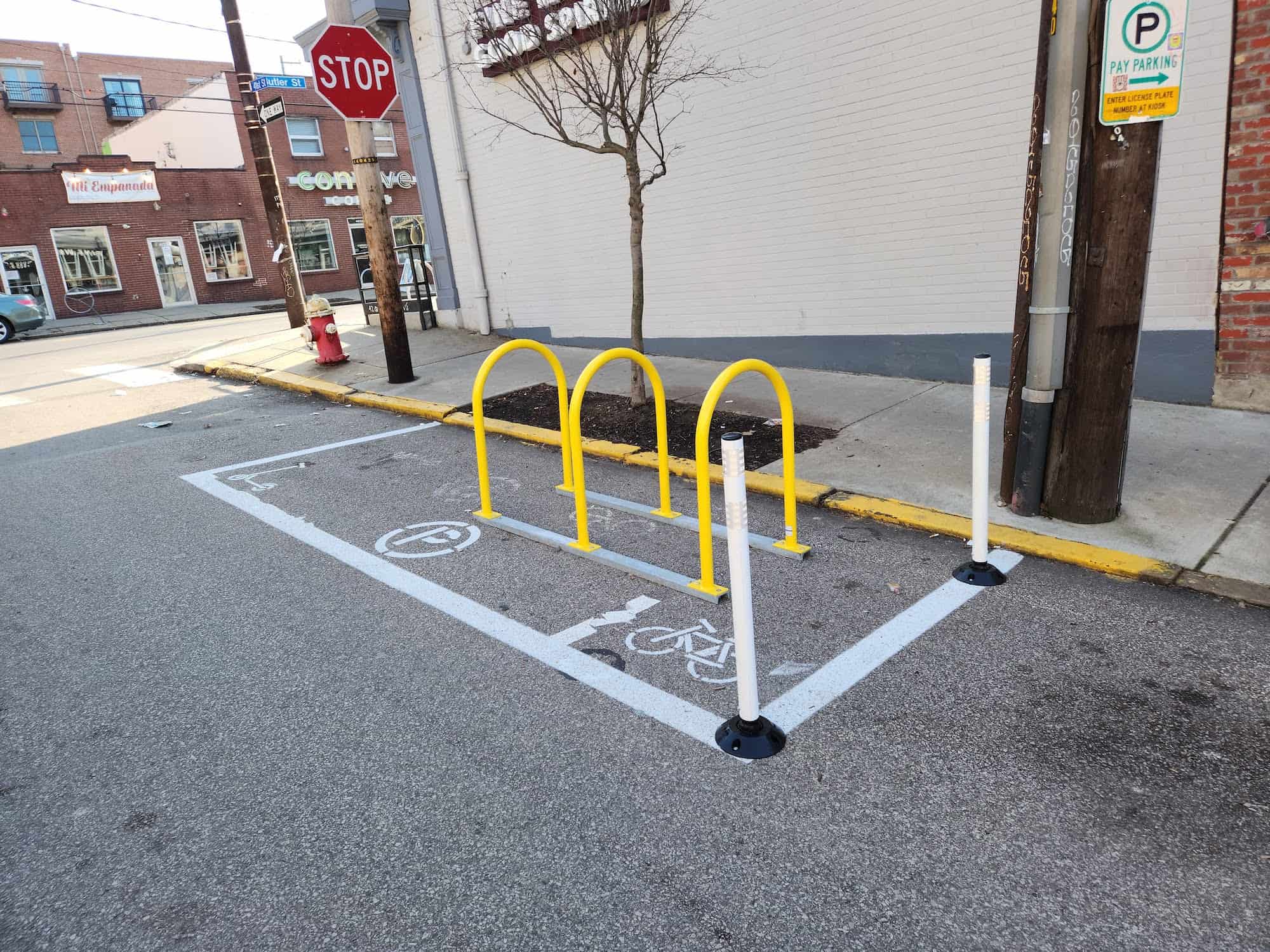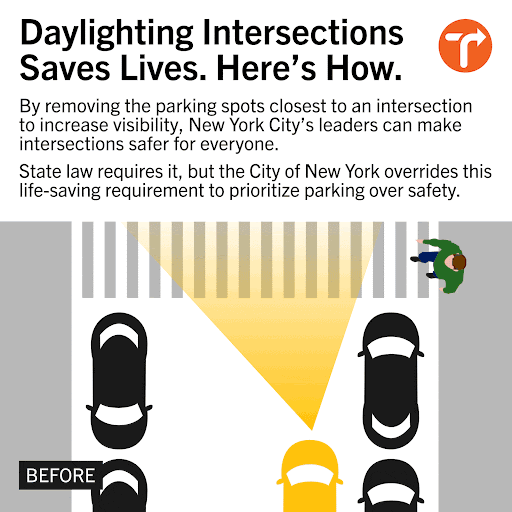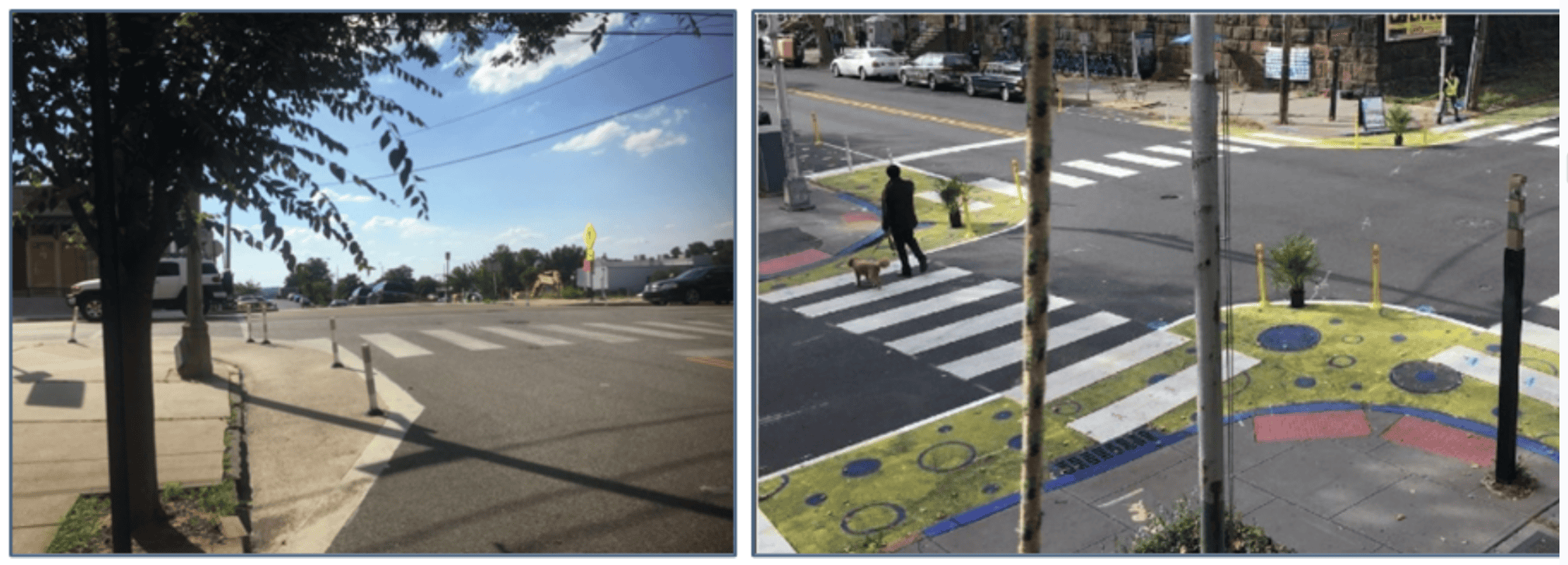
Avoiding a potentially deadly crash with another driver or a person outside of a car is much easier when you can see or can be seen
People driving cars, rolling, or walking have a visceral understanding of the unease of intersections clogged with obstructions in their line of sight. Pittsburghers encounter poor sightlines regularly as they traverse through the city’s many odd-angled intersections anchoring some of our liveliest and most congested corridors. Before cars and trucks dominated our streets, these odd geometries operated less as infamous traffic nightmares and more as places people congregated for human-scale commerce and public interaction. Poor sightlines were no issue for people moving slowly and smoothly on foot or holding on to a trolley strap.

Today, even when you are certain you have the walking signal and cross in the appropriate crosswalk, it can be frightening to cross these spaces because you and the driver who could potentially hit you have a difficult time seeing each other. Should there be a risk of a crash, neither of you can react in time to avoid it.
This is where daylighting comes in.
Daylighting involves clearing the last bit of curb space leading up to all intersections where people and other vehicles might interact. By removing obstacles from these high-conflict zones and giving everyone a better line of sight, we can create a safer space for everyone moving through our intersections.
Daylighting is about seeing and being seen.
Whether you are walking, rolling, or driving, you and everyone you interact with on your city’s streets are safer when they can see what the other person is doing.
Clearing the Curb

You can clear parked vehicles from the space near intersections with something as simple as a No Parking sign, but this zone can be clarified for drivers even further with things like paint, decorative planters, and plastic posts.
More financially and design intensive daylighting treatments can involve installing concrete bumpouts or concrete curb extensions.

Daylighting also minimizes the distance people must cross when they get to an intersection. The less time people spend in the intersection, the less time they spend at risk of striking or being struck by another person also traveling through that intersection.
Daylighting is the Law

Daylighting improves conditions for people using our streets regardless of mode, but it has long been the law for approaches to intersections to be free of obstructions, notably of parked cars. Pittsburgh City and Pennsylvania State code specify that cars cannot stand or park within 20 feet of a crosswalk or within 30 feet of a traffic sign or signal.
Management of the curb near intersections is highlighted as a key strategy in the Pittsburgh Pedestrian Safety Action Plan adopted in 2020.
Model: Daylighting in Jersey City
A combination of quick-build infrastructure and pedestrian-safety-focused enforcement all played a part in Jersey City achieving a landmark of zero deaths on its city streets in 2022.
Jersey City is located within the transit-accessible area of New York City. While JC is denser than Pittsburgh, it carries a similar population of 292,000 versus Pittsburgh’s 300,000.
Using treatments like signage, paint, and vertical delineators, they sought to eliminate ambiguity over where it is or is not legal to park, especially within 25 feet of crosswalks. (Jersey City, 2024) In 2023, Jersey City issued 346,000 parking violations. 27,000 of them were issued to those who put vulnerable road users at risk, including parking on and near crosswalks, bike lanes, or sidewalks. (Jersey City, 2023)
They coupled these efforts with on-site community and agency engagement in lieu of extended community engagement processes and successfully implemented pedestrian safety improvements throughout their High Injury Network in months rather than years (Mieleszko, 2023). These improvements are outlined in detail in their Pedestrian Enhancement Plan from 2018.
How does a clogged curb hurt Pittsburghers?
To mitigate the dangers faced by walking, biking, and rolling, it is imperative we focus on the nexus point of the intersection.
Since 2019, the simple act of moving around the city has claimed the lives of 107 people.
While 3.6% of all crashes regardless of mode led to a person being killed or seriously injured, 15.3% of people hit while walking, biking, or rolling were killed or seriously injured. This far outpaces the 2.9% of people killed or seriously injured while driving or being driven in a vehicle.
If someone is hit while outside of a car, they are 7.7 times more likely to be killed than if they are inside of a car.
This grave risk is amplified at intersections, where 30% of crashes involving our most vulnerable road users occur. (City of Pittsburgh, 2023)
Pittsburgh’s Department of Mobility and Infrastructure has started to include daylighting as a part of their efforts to calm traffic and improve safety on corridors throughout the city on a project-by-project basis.

Brighten Up Pittsburgh!
Daylighting is already a part of doing business in improving Pittsburgh’s streets. How can we start to implement it city-wide?
Daylighting Pittsburgh’s many intersections can be done quickly and cheaply while providing immense safety benefits to people regardless of how they are traveling in the city.
Traffic engineers understand the importance of sight distance well. Millions of dollars have been poured into municipal budgets to replace traffic signals so they can be seen at a greater distance and in more lighting conditions. Even as traffic signals get bigger and brighter, pedestrian crossings are not getting the same treatment.
Parking near crosswalks acts like a wall, making it more difficult for pedestrians, bicyclists and drivers alike to see each other and safely negotiate how they move.
For far less than the cost of a traffic signal replacement, we can Brighten Up our streets and keep Pittsburghers safer.
Even if prices to install treatments similar to those used by Hoboken have doubled to $80 per intersection, we could daylight 100 intersections a year for a mere $8,000.
For people walking and rolling, $8000 would be a small price to pay for a large leap in safety.
So, Brighten Up our streets and make Pittsburgh the safest city in America!

Call to action:
5 ways to Daylight your Street
- Put in a 311 Request for the City to install No Parking Signs at a crowded crosswalk on your block.
- Type in the type of sign (No Parking Sign) and include that people are parking illegally too close to the crosswalk. You can include details like that the cars are blocking your or drivers visibility. If you have narrowly missed being hit because of this, be sure to include that detail as well. If you happened to snap a photo of cars parking there illegally, you can also upload the photo.
- If you already have no parking signs and people still park illegally, you can call 911 to report Illegal Parking. If you are not comfortable doing so, you can still report this to 311 but this will likely not be resolved or addressed through 311. Should you decide to call 911, you will not be required to stay on the scene for the officer to ticket the car.
- If you are a property owner at an intersection, you can get a Minor Encroachment Permit from the city’s Department of Mobility and Infrastructure and install something like planters at the intersection to prevent cars from parking illegally too close to the crosswalk.
- This is a more involved process that requires more work than other options but can achieve lasting results!
- Email your City Council Representative and (politely) let them know about your concerns about Illegal Parking near crosswalks and provide them with any evidence you have of the issues you are facing and point out the intersections where it is a problem.
- Tactical Urbanism!
- If you have exhausted your official channels, some inexpensive things can be used to daylight an intersection and prevent people parking in or near the crosswalk. This can be things like decorative planters, paint, cones or plastic posts. Be aware that this is not strictly legal and might be removed by the city at any time after you place it. For best results, get your neighbors involved early in the planning process! They can help you put them in and letting them in on your plans could help prevent any angry calls to the city that might have your intervention quickly reversed.
*A special thanks to our summer intern, Morgan Shaw, for researching and writing this article.